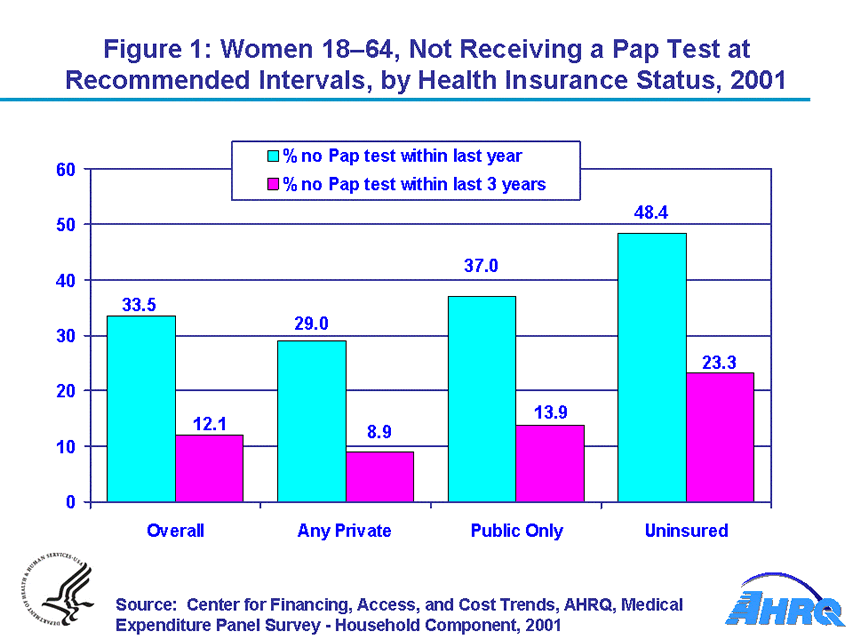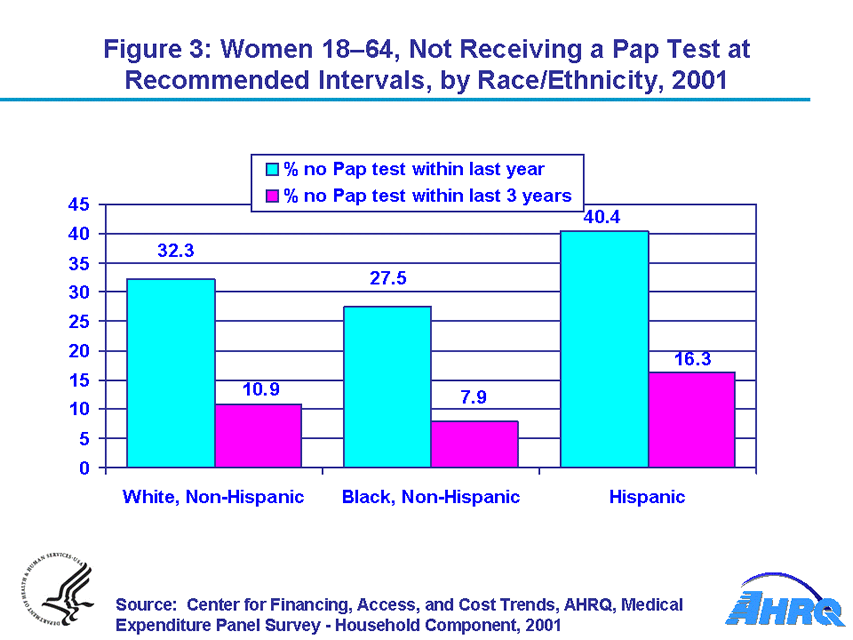
|
|
Font Size:
|
||||
|
|
|
|
||||
STATISTICAL BRIEF #26:
Use of the Pap Test as a Cancer Screening Tool--2001
Briefly Stated
- Overall, about 12% of women aged 18-64 did not receive Pap test screening within the last 3 years.
- Women 18-64 with public health insurance only, or those who were uninsured, were more likely to not have received a Pap test screening than those with private health insurance.
- The less education a woman attained, the more likely she was to not have received a Pap test screening.
- Hispanic women were more likely than non-Hispanic white or non-Hispanic black women to not have received a Pap test screening within the last 3 years.
Introduction
Screening with cervical cytology (the "Pap test") helps to reduce the incidence of and mortality from cervical cancer. The U.S. Preventive Services Task Force (USPSTF) guidelines recommend screening for cervical cancer at least every 3 years for women over 18 who have been sexually active and have an intact cervix1. The American Cancer Society, National Cancer Institute, American College of Obstetricians and Gynecologists, American Medical Association, American Academy of Family Physicians, and others recommend the screenings begin at age 18 (or at the onset of sexual activity), with annual tests recommended for at least 3 years. The frequency of screenings can then be reduced at the discretion of the doctor and patient after three or more consecutive satisfactory normal annual examinations1.
Health insurance coverage and demographic characteristics, which are associated with individual use of health services, can also be associated with access to and use of preventive services. This report examines the relationships between health insurance coverage, education level, race/ethnicity, and Pap test screening rates among women between the ages of 18 and 64 in the U.S. civilian non-institutionalized population in 2001. All differences discussed in this Statistical Brief are statistically significant at the .05 level.
Findings
Based on data from the 2001 Medical Expenditure Panel Survey (MEPS), 33.5% of women aged 18-64 did not have a Pap test screening within the last year, and 12.1% did not receive the Pap test screening within the last 3 years (Figure 1). The rate of Pap test screening varied considerably by health insurance coverage status. Women with public health insurance only or those who were uninsured were less likely to have received a Pap test screening than women with private health insurance. Nearly 14% of women with public insurance and approximately 23% of those who were uninsured did not receive a Pap test screening within the recommended 3-year interval. Only 8.9% of women who had any private insurance were not screened.
Pap test screening rates also varied by education level for women aged 18-64 (Figure 2). The lower the level of education a woman attained, the less likely she was to have received a Pap test screening within the last 3 years. Approximately 22% of the women with less than a high school education did not receive the screening, compared to just under 8% of women with some college education and approximately 13% of those having completed high school.
As shown in Figure 3, the rate of Pap test screening also varied by race/ethnicity. More specifically, 7.9% of non-Hispanic black women and 10.9% of non-Hispanic white women did not receive a Pap test in the recommended 3-year interval. Over 16% of Hispanic women did not receive a Pap test within 3 years, making them over twice as likely as blacks, and significantly more likely than whites, to have not obtained the recommended screening.
About MEPS
The estimates in this Statistical Brief are based on data from the 2001 MEPS Household Component (MEPS-HC). This data set contains a sample of persons with a response rate of about 71.4%. The MEPS is a nationally representative longitudinal survey that collects detailed information on healthcare utilization and expenditures, health insurance, and health status, as well as a wide variety of social, demographic, and economic characteristics for the civilian non-institutionalized population. This Statistical Brief examines the preventive care data that were collected in Rounds 3 and 5 of the MEPS survey. Data on Pap test screening was missing for about 2.5% of women. Race/ethnicity was assigned hierarchically into the Hispanic, white non-Hispanic, black non-Hispanic, and other categories. Health insurance coverage was assigned hierarchically, based on a person's health insurance status at any time throughout the year, into any private, public only, and uninsured. Tricare is included as private coverage. More information about MEPS can be found at the MEPS Web site at http://www.meps.ahrq.gov/.
For a detailed description of the MEPS survey design, sample design, and methods used to reduce sources of nonsampling error, see the following publications:
Cohen, J. Design and Methods of the Medical Expenditure Panel Survey Household Component: Rockville (MD) Agency for Health Care Policy and Research; 1997. MEPS Methodology Report No. 1. AHCPR Pub. No. 97-0026.
Cohen, S. Sample Design of the 1996 Medical Expenditure Panel Survey Household Component. Rockville (MD) Agency for Health Care Policy and Research; 1997. MEPS Methodology Report No. 2. AHCPR Pub. No. 97-0027.
For more information on current guidelines for cancer screenings, see the following sources:
Guide to Clinical Preventive Services, Report of the U.S. Preventive Services Task Force, 3rd Edition: Periodic Updates (available Winter 2002/03), Screening for Cervical Cancer, 2003.
USPSTF guidelines are also available at http://ahrq.gov/clinic/3rduspstf/cervcan/cervcanwh.htm
Footnote
1 Recommendations in effect during the data period referenced.
 |
|||||||||||||||||||||||||
|
|||||||||||||||||||||||||
|
|
|||||||||||||||||||||||||
 |
|||||||||||||||||||||||||
|
|||||||||||||||||||||||||
|
|
|||||||||||||||||||||||||
 |
|||||||||||||||||||||||||
|
|||||||||||||||||||||||||
|
|
|||||||||||||||||||||||||


